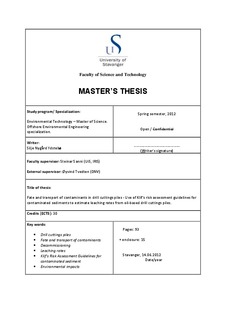| dc.description.abstract | The North Sea contains several oil-based drill cuttings piles which have accumulated on the seabed
as a result of oil and gas production. An increased awareness of the contaminants within these piles
has grown over the years since several platforms are to be decommissioned. Possible relocation of
cuttings piles might result in release of contaminants from the drill cuttings, possibly affecting local
organisms. It has been of interest to determine rates at which contaminants, total hydrocarbon (THC)
in particular, are leaching out to the environment from these piles. This can be done by physical
analyses in the laboratory, such as shaking tests, or by mathematical models. The Norwegian Climate
and Pollution Agency (Klif) has prepared risk assessment guidelines for contaminated sediments in
coastal areas and fjords which includes diffusion calculations. The objective of this thesis is to
examine if these guidelines can be used to calculate leaching rates from oil-based drill cuttings piles
in the North Sea. Data from drill cuttings piles at Statfjord A was used as basis for the calculations in
this study. THC is the main contaminant of concern, determining the leaching rate of THC would
therefore be preferred. This was not possible however, due to the fact that THC is not included in the
guidelines. The leaching rates are thus calculated based on poly aromatic hydrocarbons (PAH), which
often represent the most toxic part of drill cuttings piles. The calculated maximum and mean PAH
leaching rates, based on equations given in Klif’s guidelines, was determined to be 41,2 kg/year and
3,40 kg/year respectively. Several factors of uncertainty with regards to these calculations, such as
extensive use of default values and the possibility that processes not included in the guidelines might
contribute to the spreading, and lack of comparison values, makes it difficult to evaluate the accuracy
of these leaching rates. However, the estimated time to drain the sediment for contaminants was
rapid for some of the PAHs, which might indicate overestimations in the calculations. The
environmental impact results show that several of the PAHs are exceeding their respective limit
values given in Klif’s guidelines. This might indicate that leaching of PAHs from the drill cuttings piles
might affect the species living in, on or possibly near the drill cuttings piles.
This study shows that there are several limitations when using Klif’s guidelines to determine leaching
rates from oil-based drill cuttings piles. Critical parameters are deficient from both the guidelines and
the drill cuttings characterization reports to be able to get reliable results. In addition, uncertainty
arises due to the fact that the guidelines are based on conditions in harbors and coastal areas and
not conditions present in the North Sea. The sum of these uncertainties indicates that the calculated
results cannot be considered reliable, and that the present guideline is not feasible to use on oilcontaminated
drill cuttings piles. However, the study might provide useful information on factors
that should be present to calculate leaching rates from oil-based drill cuttings piles. | no_NO |
